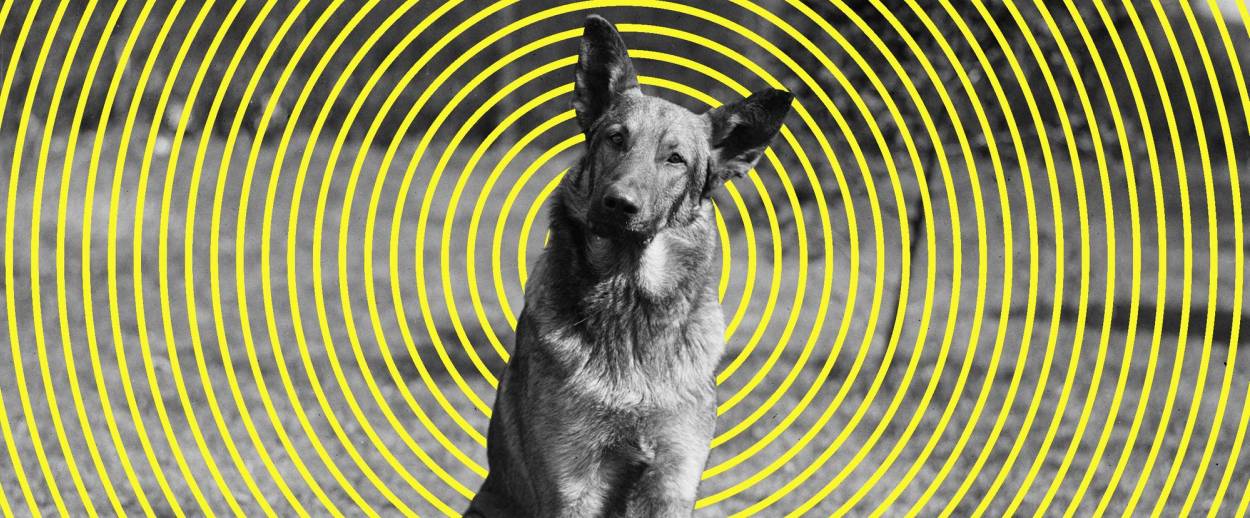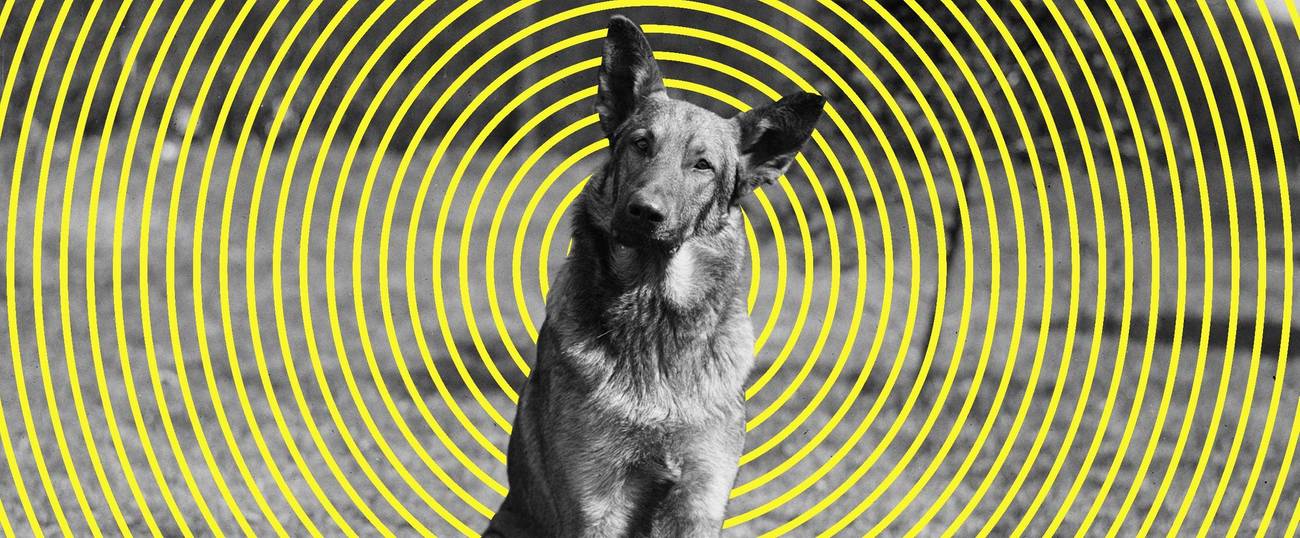Dog Days
Jewish women in my life taught me to fear dogs. Therapy helped me stop.




As our cab pulled into the circular driveway, I felt a familiar flush of symptoms. One minute I had been fine. The next, my palms were sweating profusely, my heart was beating fast and loudly, the air felt thinner, and my surroundings were starting to spin. I was terrified, and it had nothing to do with the fact that I was about to meet my then-boyfriend’s parents for the first time. The family member I was most afraid of meeting was Charlie the dog. For as long as I can remember, I have been afflicted with cynophobia. The term sounds strange, and to most people, the fear that it represents is equally strange. Why would anyone be terrified of man’s best friend?
Those of us who are afraid can come up with many reasons, some more rational than others. Dogs bark. They bite. They are often faster and stronger than we are. Most of all, it is impossible to ever know what they are truly thinking. As a result, there’s no way to negotiate. There’s no way to convince them that if they decide not to attack, you’ll let them eat as much kibble as theyb want, or set them free in some unassuming national park. As a youngest child, I learned early on that I would get nowhere if I didn’t learn to effectively communicate my thoughts. The next youngest person at my dinner table was always 9 years older than me, and my siblings never cut me any slack when I chimed into debates over politics or ideology despite my thoughts not being nearly as fleshed out as their more fully formed beliefs. The thing is, though, all this debater-ly experience wouldn’t defeat a dog that threatened to bite.
Most phobias, and certainly mine, are really about having an overwhelming and overpowering sense of powerlessness. The roots are more complicated, however. One of the main ways that people develop fears is by learning them from their peers and superiors. Often times, that’s a good thing. It is sometimes even critically important for our survival. As children, we learn not to stick our hands on the stove from the stern warnings our parents give us. As adults, we learn to answer our jury duty notices from the stern warnings the U.S. government gives us. But sometimes, when the fear itself is irrational, the act of learning it is actually a very bad thing.
As a child, I often witnessed my grandmother and sister cross the street in a panic when a dog was anywhere near them. Other members of my family dislike and distrust members of the canine species, but these two women in my life were particularly fearful. They have both always been authority figures to me, older women whom I knew, loved, trusted, and relied upon. To see them cower in fear over and over and over again trained me to believe that there really was something to fear. For my grandmother, who exclusively refers to dogs in the German—Hund—there were certainly rational reasons behind her fear. Growing up in 1930s Berlin, my grandmother, my Oma, had good reason to fear her four-legged foe. That reason was that her four-legged foe was accompanied by her two-legged foes: Nazi officers and Hitler youth. The dogs that she saw on the street were not the cuddly little shih-poos and Yorkshire terriers that crowd our blocks today. They were Dobermans and German shepherds well trained to inspire fear, especially in little Jewish girls.
But for my sister, and for me, the fear of dogs was learned secondhand, and less rational. It was about what we saw growing up, and what we learned to be afraid of. After many years of debilitating fear and anxiety, I decided to do a course of cognitive behavioral therapy. I was given homework assignments. Instead of completing equations or writing papers, I was expected to listen to the sound of dogs barking, to seek out opportunities to watch them run around; ultimately, the goal was to actually spend time, one-on-one, with a real, living, breathing, unleashed dog.
During the course of my therapy, I followed all the steps except the last. I spent countless hours on YouTube channels listening to angry dogs yapping at each other. The effect was tangible and almost immediate. Whereas I was once driven to unceasing panic from the mere sound of a dog’s bark—or even from the sound of a leash jangling in the wind—my system learned to calm down and not react to audible stimulus. I spent countless hours outside doggy day cares, watching dogs play and jump all over each other, feeling safe behind a wall of thick glass. This too had an instant effect. Seeing a dog across the street no longer induced a sense of unconquerable panic. Taking the final step though, really interacting with an unleashed dog, all by myself, letting it jump all over me, these were moves I was unprepared to make until one day, I got the best kind of inspiration for exposure therapy.
*
When Bobby—whom I married in 2018—and I first pulled into that driveway, all I could think about was whether I could handle spending an entire weekend in the house with Charlie. The first day was scary, and dinner in particular was a terrifying experience, with Charlie jumping higher than I could have believed, hoping one of us would feed him a piece of our chicken. But as he kept jumping and barking and nothing bad happened, I slowly calmed down, if only a little. Dozens of more trips to the house would prove curative to an extent I now have trouble believing. Just now, during the week between Christmas and New Year’s, Bobby and I were alone with Charlie in Colorado. For an entire week, we were responsible for feeding, walking, medicating, and playing with a being who was totally and utterly dependent on us. The feelings that followed—a sense of duty, protectiveness, responsibility—would have once been unimaginable to me in the context of a dog. And yet despite my history, I found myself thrilled to realize that Charlie would run to the door to greet us when he heard the sound of our car entering the garage. I was amused, and blown away by his intelligence, and I was amused and blown away by my reaction to it.
Each day, Charlie takes a pill for some canine health issue I don’t know anything about. But Charlie, like the rest of us, does not particularly enjoy taking medicine. And so the geniuses in the dog industry have come up with the pill pocket. It’s a foul-smelling light brown mushy “treat”—if you can call it that—that looks like a Rolo with a hole on top. We were given clear instructions by my in-laws: Insert the pill into the pocket, squeeze the top, and give Charlie his treat. But most of the time, Charlie was not fooled by our deception. He dug the pill out of the treat, turned his nose up at the medicine that to him clearly smelled fouler than his nosh, and ate only the treat. As this was happening, and as I found myself smiling, with pride, marveling at his smarts, I paused to think about how I would have reacted to this only a year or two ago. My thought process would have been a spiraling mess of panic and chaos: “The dog is brilliant, it can see right through our deceptions. I think the dog is smarter than us.” “Does the dog know how to open the latch on the carrier he sleeps in?” “What if the dog unlocks the carrier in the middle of the night and comes into our bed and kills us for trying to give him the medicine? And for locking him in there?”
I’m told that this type of thinking is pretty common in people who seek CBT. And yet, a fear of dogs is a common fear, going well beyond those who seek treatment. And for Jews, it goes back a long time, long before the Nazis and my grandmother’s Berlin days. The Talmud mentions a woman who miscarried from the mere sound of a dog’s bark. Maimonides’ Mishneh Torah says that the sages curse dog breeders and demands that dogs be chained during the day because of their propensity for causing damage. Sefer Melachim—the first Book of Kings—has a few instances of dogs feasting on human bodies. There’s even a phrase from Exodus about how dogs didn’t snarl at Jews—proof of God distinguishing them from the Egyptians—that I was once told to chant to myself whenever I was afraid and confronted with a dog. And chant it, I did.
But while words have power, and saying that over and over to myself used to calm me a little, deeds have more power. One important thing you learn in CBT is that avoidance only begets more avoidance and ultimately exacerbates and expands any kind of fear. But avoidance, like any bad habit, can always creep back up on you. Conquering a fear is like learning a new language—if you stop practicing verb conjugation, you’ll never get fluent. If you’re not actively restraining yourself from falling back into those easy, tempting, avoidance habits, the sweaty palms and racing heart will return. The process is long and challenging, and it never really ends. But I am not afraid of Charlie any more.
***
Like this article? Sign up for our Daily Digest to get Tablet magazine’s new content in your inbox each morning.
Daniella Greenbaum Davis is a writer living in New York. Follow her @Dgreenbaum.